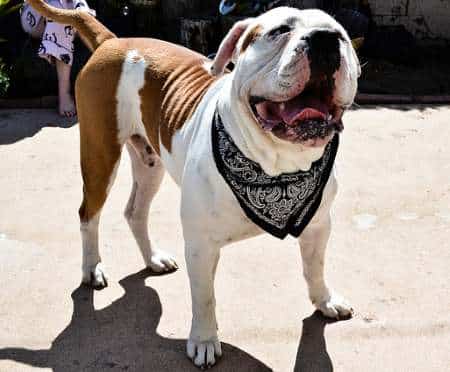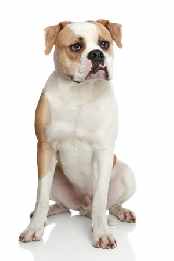Steadfast, Powerful, Vigorous
The American Bulldog is considered one of many different “bully” breeds, each of which is unique to some degree.
All bulldog breeds are descended from a deliberate mix of bull baiting dogs that were selected for the endurance, strength, and toughness.
American Bulldog
They also have some terrier DNA because the terrier gives the dog intelligence and agility. All bull dogs were developed to fill one of three roles: Farm work, Guarding or for use in dog fighting sports.

Fiercely loyal, intelligent, and stable, these dogs make excellent family pets. They are loving but very dominant, so they need an owner that is confident and willing to assume the role of the dominant person.
American Bulldog – Children
They love children, especially when they are raised around them, but their size and strength may too much for small children.
Good owners will teach their dog to be gentle from day one to prevent any children to be accidentally knocked over, even if all the dog wanted to do was shower them with slobbery kisses.

Dog to Dog Aggression
Some members of this breed may be aggressive with other dogs, especially those of the same sex.
Some may become aggressive with other dogs while out and about. It is important to socialize these dogs from an early age to tolerate friendly dogs so as to avoid any possible fighting.
They were developed to catch wild boar so some of them may not be reliable around larger animals such as horses. Many do not do well with cats, so caution is advised.
Energy, Activity, Exercise Requirements
The American Bulldog is highly energetic and active and will require plenty of exercise.
Exercise in the form of long daily walks will help, but daily romps and playtime are also necessary. Start slowly with very young puppies and work up to a comfortable exercise regime.
They are amazing jumpers due to their massive muscle structure and can be little escape artists if there is a small opening in the fence.
They have also been known to be diggers due to the terrier in their background. As puppies, they can be rowdy and destructive if left alone for extended periods of time.
Living Arrangements
This breed can do well in an apartment provided that they get enough exercise on a daily basis.
Many larger breed dogs are calm and quiet indoors and more active outside. This is also the case with the American Bulldog.
Ideal, these dogs need room to run in a securely fenced area. A suburban or rural location would be good.
American Bulldog – Breed History
Most dog breeds do not have a concise, clearly written history of their development, even some of the newer breeds to be established. The American Bulldog’s history is no exception.
There are several theories about its development. Some may agree with the one I’ve written below and others will site other scenarios for how their history played out.
Early Bulldogs in the United Kingdom were developed to do a job, and selective breeding was targeted at creating dogs that were best suited for the job.
Their appearance and conformation that we take for granted today were not necessary. They looked very different from the English Bulldog (British Bulldog or just Bulldog, depending on where you live in the world) that we know today.
When English settlers from the West Midlands of England immigrated to the United States, they brought their farm dogs and settled in the southern portion of the country.
They were used to kill off vermin and protect the crops and livestock from feral pigs that became a problem in the 1800s.

Photo Courtesy Kingston (Flickr)
By World War II, these Bulldogs were all but extinct. With the help of John D. Johnson and his father, they searched throughout the South to find the best specimens.
Alan Scott took an interest in Johnson’s work and worked with him to revive the breed. Scott added other southern Bulldogs to create the now Standard American Bulldog. Both worked together for awhile but then went their separate ways creating two slightly different versions of the same breed.
The Johnson line or Classic version was larger, muscular with bigger bones. They had facial wrinkles, an undershot jaw, and shorter muzzle. He used an English Bulldog at one point to create a dog that was less athletic and looked more like the English Bulldog.
The Standard / Performance or Scott line looked a little more like a Pit Bull. Longer legs that were carried under the body rather than out to the side, longer muzzle and very muscular, this variety was more athletic.
In the 1970s, a third line was developed which resembled the Standard / Performance but was to be used in dog fighting.
Vital Statistics
Weight
Male 32–54 kg (70–120 lbs)
Bully type (85–130 lbs) 39-59kg
Female (60–90) lbs 27-41 kg
Height
Male 50–65 cm (20–26 in)
Female 20–24 in
Life Expectancy
10-16 years although the average is 10-11 years.
Colors
They are predominately white but can also have patches of:
Black
Red
Brown
Fawn
All shades of brindle.
American Bulldog – Ease of Training

This breed wants to please, but sometimes their need to do it their own way interferes with your requests. A positive approach is necessary because deep down they are sensitive and do not respond well to punishment. Food rewards are often the training of choice, but it also takes a strong leader to be the owner of these dogs.
Housebreaking can be challenging because these dogs were never meant to be pampered pooch like some of the toy breeds. The ideal owner will be committed, consistent, and patient while helping to make this fearless breed into a sociable house pet.
Any method of harsh training such as hitting or yelling will not work and may backfire on you. The best way to train is through frequent, short, sessions that are fun for the dog. If you feel yourself getting frustrated or annoyed, stop and pick up at a later time.
Some trainers suggest that any type of games that can be perceived as a struggle for dominance or control should be avoided. This would include tug of war. Their rationale for this is that you don’t want the dog to think of you as a rival for control.
Most experts suggest that owners of the American Bulldog enroll in at least one or more obedience classes. These serve not only to train the dog in basic commands but also helps socialize the dog around other dogs.
Protection
One of the early jobs that these dogs were trained to do was to guard. They are naturally suspicious of strangers and fiercely loyal to their humans.
At over 100 pounds in some members of the breed, they can look imposing, making them a deterrent for would-be intruders.
Without early socialization as well as ongoing training, they can be guards, and dangerous to anyone or anything that they don’t know. They are not big barkers, but will alert you if someone is nearby.
Socialization helps these dogs to be able to differentiate friend from foe and is absolutely necessary if you want a peaceful household. The last thing you want is for one of your children’s buddies to casually wander in and startle your bully.
Grooming
This short haired breed does not require lots of time to groom. A good brushing once or twice a week with a bristle brush or a rubber hound glove will remove dead hair and keep shedding under control.
They are not generally considered to be a dirty breed, and they don’t have a doggy smell. However, most all American Bulldogs are white, so if you like your bully to be sparkling, an occasional bath is important.
Nails also need to be clipped or ground down using a Dremel type tool. Their nails grow rapidly so a nail trim about every 2 to 3 weeks should keep the nails from clicking on your floors. Frequent nail clipping also prevents the quick or blood vessel at the center of the toenail to lengthen, making it difficult to ever keep the nails short.
Just like their English cousin, the American Bulldog may drool and slobber. A handy rag to wipe off drool may be necessary if your AB is a big drooler.
Health Considerations
This is a relatively healthy breed with a life expectancy of 10-16 years. Like all breeds, certain genetic issues have been identified as occurring, and some of the inherited conditions have health tests that can be performed on the breeding pair.
The most important conditions to be aware of are;
- Neuronal Ceroid Lipofuscinosis (NCL) a nervous system disorder (Test available)
- Ichthyosis: Skin Disease (Test Available) This severe flaking skin condition gets its name for the large dry flakes that resemble fish scales. Affected puppies are born with the problem. There are a few palliative measures, but there is no cure.
- Hip Dysplasia (Test Available) An abnormal development of the hip joint. Hips should be checked before breeding and can be certified through OFA Orthopedia Foundation of America or Penn Hip
- Elbow dysplasia (Test Available) An abnormal development of the elbow joint
- Bone Cancer (Fibrosarcoma)
- Hypothyroidism: a very common endocrine condition which occurs when the body does not produce enough thyroid hormones.
- Entropion (a portion of the eyelid folds inward towards the eyeball
If you decide to purchase an American Bulldog from a breeder, it is imperative that you check them out thoroughly.
They should be able to provide health certificates and screens their breeding stock for hips and elbows. If they are not forthcoming with information, ask them outright: What tests do you do on your breeding dogs?
An eye exam can also be done on adults and any that cannot pass it should not be breed. Ask for a health warranty.
Even though these dogs are not eligible to be registered with the American Kennel Club, ask the breeder what type of registration is provided.
Famous Dogs
Chance from the movie, Homeward Bound: The Incredible Journey, and Homeward Bound II: Lost in San Francisco



